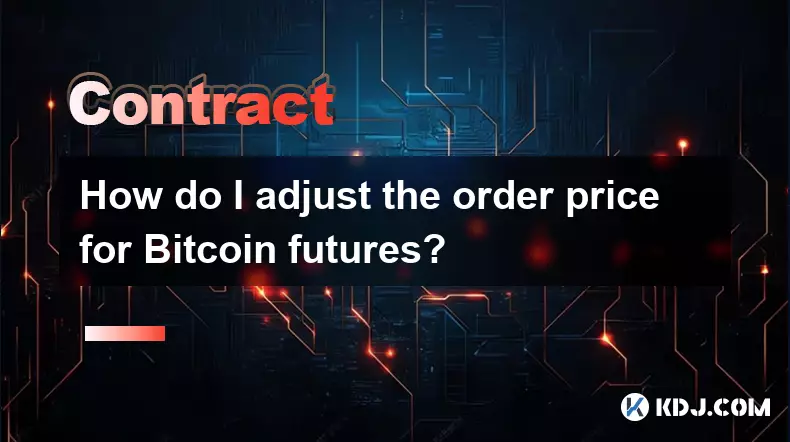-
 bitcoin
bitcoin $122025.899241 USD
-2.12% -
 ethereum
ethereum $4488.068729 USD
-4.11% -
 bnb
bnb $1315.348019 USD
8.65% -
 tether
tether $1.000457 USD
0.03% -
 xrp
xrp $2.875326 USD
-3.69% -
 solana
solana $222.043604 USD
-4.07% -
 usd-coin
usd-coin $0.999682 USD
0.00% -
 dogecoin
dogecoin $0.249887 USD
-5.62% -
 tron
tron $0.337379 USD
-2.59% -
 cardano
cardano $0.827763 USD
-5.06% -
 hyperliquid
hyperliquid $45.774531 USD
-2.43% -
 chainlink
chainlink $22.079309 USD
-5.87% -
 ethena-usde
ethena-usde $1.000156 USD
0.02% -
 sui
sui $3.482566 USD
-3.57% -
 stellar
stellar $0.386982 USD
-4.92%
How do I adjust the order price for Bitcoin futures?
Bitcoin futures pricing hinges on spot prices, funding rates, and market sentiment, with order types and liquidity shaping execution quality and strategy effectiveness.
Sep 25, 2025 at 12:01 pm

Understanding Bitcoin Futures Pricing Mechanisms
1. Bitcoin futures contracts derive their value from the anticipated price of Bitcoin at a future date. These instruments are traded on regulated exchanges such as CME, Bakkt, and Bybit, where pricing is influenced by spot prices, funding rates, and market sentiment. Traders must understand that the futures price often diverges from the spot price due to premiums or discounts in the market.
2. The order price for Bitcoin futures can be adjusted based on the type of order placed—limit, market, stop-limit, or conditional orders. A limit order allows traders to set a specific price at which they wish to enter or exit a position. This gives control over execution but does not guarantee immediate fill if the market doesn't reach the specified level.
3. Market orders execute instantly at the best available price but may result in slippage during periods of high volatility. For precise control over entry and exit points, especially in fast-moving markets, adjusting the limit price slightly away from the current mark price can help avoid unfavorable fills.
4. Funding rates play a critical role in perpetual futures contracts. These periodic payments between long and short positions influence the spread between futures and spot prices. When funding rates are positive, longs pay shorts, indicating bullish sentiment; when negative, shorts pay longs, signaling bearish bias. Adjusting order prices should account for these dynamics to optimize entry timing.
5. Monitoring open interest and volume data helps assess market positioning. Sudden spikes in open interest alongside rising prices suggest new money entering the market, potentially validating trend continuation. Conversely, declining open interest during price moves may indicate liquidation-driven action, prompting cautious order placement.
Strategies for Modifying Order Prices
1. Utilizing limit orders with tight spreads requires constant monitoring of order book depth. Placing bids slightly below the best bid or asks slightly above the best ask increases the chance of execution while maintaining favorable pricing. This strategy works well in range-bound or low-volatility environments.
2. In trending markets, using trailing stop orders allows dynamic adjustment of entry or exit points. As the price moves favorably, the stop level adjusts automatically, locking in profits without requiring manual intervention. This method suits momentum traders aiming to capture extended moves.
3. Scaling into positions by splitting large orders into smaller ones reduces market impact. For example, instead of placing a single 10 BTC buy order, divide it into five 2 BTC limit orders at incremental price levels. This approach smoothens average entry cost and mitigates risk from sudden reversals.
4. Incorporating technical indicators like moving averages, RSI, or Bollinger Bands aids in identifying optimal zones for price adjustments. Buying near support levels with oversold RSI readings offers higher probability setups, justifying tighter limit placements. Similarly, selling into resistance with overbought signals supports strategic order pricing.
5. Algorithmic trading bots can automate price adjustments based on predefined rules. These systems react faster than manual inputs, adjusting limit prices in response to real-time liquidity changes, volatility shifts, or news events. Custom scripts can be configured to reprice orders when certain thresholds are met.
Risks Associated with Price Adjustments
1. Frequent modification of order prices without a clear plan may lead to overtrading. Each adjustment introduces decision fatigue and potential emotional bias, increasing the likelihood of impulsive actions during volatile periods.
2. Narrow spreads increase the risk of non-execution, especially during rapid price swings. An order placed too close to the mid-price might get skipped entirely if the market gaps through the level, causing missed opportunities.
3. Liquidity fragmentation across exchanges affects order fulfillment. Some platforms exhibit shallow order books, making large adjustments ineffective unless matched with sufficient counterparties. Traders should prioritize venues with deep liquidity and transparent fee structures.
4. Flash crashes or spoofing activities can trigger false breakouts, leading to premature order executions. Malicious actors sometimes place large fake orders to manipulate price perception before canceling them. Adjusting prices too aggressively in such scenarios results in poor fills.
Maintaining discipline in order management prevents reactive decisions. Sticking to a pre-defined strategy ensures consistency even when market conditions fluctuate unpredictably.Frequently Asked Questions
What is the difference between mark price and last traded price in Bitcoin futures?The last traded price reflects the most recent transaction on the order book, while the mark price is a calculated value used to prevent manipulation. It typically combines spot index prices with funding rate adjustments to determine fair valuation for margining and liquidations.
Can I change my limit order price after submission?Yes, most exchanges allow users to modify or cancel open limit orders before execution. Access the active orders section, select the specific trade, and update the price or quantity accordingly. Execution depends on prevailing market conditions post-adjustment.
Why did my limit order not execute even though the price appeared to reach my level?This often occurs due to latency, insufficient size at the desired level, or discrepancies between the last traded price and actual bid/ask depth. The market may have briefly touched your price but lacked matching sell/buy volume for full execution.
How do funding rates affect my order pricing strategy?High positive funding incentivizes short entries as longs pay fees, potentially creating downward pressure. Conversely, negative funding rewards long holders, supporting upward momentum. Factoring in these costs helps refine entry and exit levels for better net returns.
Disclaimer:info@kdj.com
The information provided is not trading advice. kdj.com does not assume any responsibility for any investments made based on the information provided in this article. Cryptocurrencies are highly volatile and it is highly recommended that you invest with caution after thorough research!
If you believe that the content used on this website infringes your copyright, please contact us immediately (info@kdj.com) and we will delete it promptly.
- BlockDAG, DOGE, HYPE Sponsorship: Crypto Trends Shaping 2025
- 2025-10-01 00:25:13
- Deutsche Börse and Circle: A StableCoin Adoption Powerhouse in Europe
- 2025-10-01 00:25:13
- BlockDAG's Presale Buzz: Is It the Crypto to Watch in October 2025?
- 2025-10-01 00:30:13
- Bitcoin, Crypto, and IQ: When Genius Meets Digital Gold?
- 2025-10-01 00:30:13
- Stablecoins, American Innovation, and Wallet Tokens: The Next Frontier
- 2025-10-01 00:35:12
- NBU, Coins, and Crypto in Ukraine: A New Yorker's Take
- 2025-10-01 00:45:14
Related knowledge

What is the difference between futures and perpetual contracts for Bitcoin?
Oct 02,2025 at 11:54pm
Understanding Bitcoin Futures Contracts1. Bitcoin futures are derivative instruments that allow traders to speculate on the future price of Bitcoin at...

What is the best time to trade PEPE contracts?
Oct 03,2025 at 11:54am
Understanding PEPE Contract Volatility1. PEPE contracts exhibit extreme price fluctuations due to their meme-based nature and low market cap. Trading ...

What are the common mistakes to avoid with Bitcoincoin contracts?
Oct 03,2025 at 08:54am
Emerging Trends in the Cryptocurrency Market1. Decentralized finance (DeFi) platforms continue to expand their influence across the blockchain ecosyst...

What is the maintenance margin for Bitcoin contracts?
Oct 02,2025 at 01:36am
Decentralized Exchanges Gain Momentum in 20241. Decentralized exchanges (DEXs) have seen a significant rise in trading volume, surpassing centralized ...

How to use technical analysis for trading XRP contracts?
Oct 03,2025 at 01:18pm
Understanding Price Patterns in XRP Futures1. Identifying chart patterns such as triangles, head and shoulders, and double tops or bottoms can provide...

What does "longing" PEPE contracts mean?
Oct 03,2025 at 11:54pm
Understanding Decentralized Exchanges in the Crypto Ecosystem1. Decentralized exchanges (DEXs) operate without a central authority, allowing users to ...

What is the difference between futures and perpetual contracts for Bitcoin?
Oct 02,2025 at 11:54pm
Understanding Bitcoin Futures Contracts1. Bitcoin futures are derivative instruments that allow traders to speculate on the future price of Bitcoin at...

What is the best time to trade PEPE contracts?
Oct 03,2025 at 11:54am
Understanding PEPE Contract Volatility1. PEPE contracts exhibit extreme price fluctuations due to their meme-based nature and low market cap. Trading ...

What are the common mistakes to avoid with Bitcoincoin contracts?
Oct 03,2025 at 08:54am
Emerging Trends in the Cryptocurrency Market1. Decentralized finance (DeFi) platforms continue to expand their influence across the blockchain ecosyst...

What is the maintenance margin for Bitcoin contracts?
Oct 02,2025 at 01:36am
Decentralized Exchanges Gain Momentum in 20241. Decentralized exchanges (DEXs) have seen a significant rise in trading volume, surpassing centralized ...

How to use technical analysis for trading XRP contracts?
Oct 03,2025 at 01:18pm
Understanding Price Patterns in XRP Futures1. Identifying chart patterns such as triangles, head and shoulders, and double tops or bottoms can provide...

What does "longing" PEPE contracts mean?
Oct 03,2025 at 11:54pm
Understanding Decentralized Exchanges in the Crypto Ecosystem1. Decentralized exchanges (DEXs) operate without a central authority, allowing users to ...
See all articles










































































